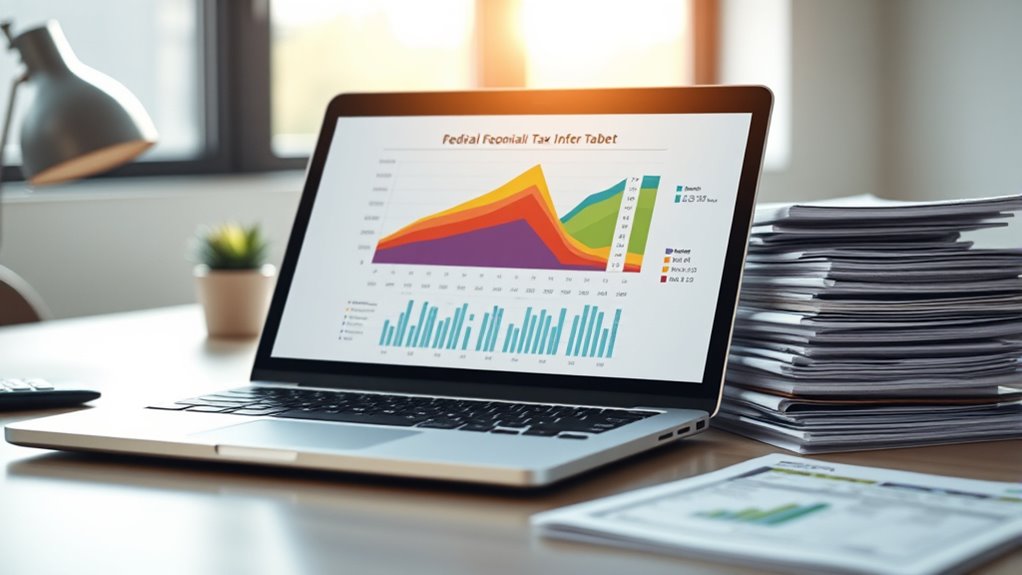In 2025, understanding the federal income tax brackets helps you see how inflation adjustments impact your taxes. The IRS raises income thresholds for each rate, meaning you might pay less at certain levels or avoid moving into higher brackets. Knowing where your income falls relative to these updated thresholds allows you to plan better, like adjusting deductions or retirement contributions. Keep exploring to discover specific threshold changes and strategies to optimize your tax situation.
Key Takeaways
- The 2025 tax brackets are adjusted annually for inflation, increasing income thresholds across most levels.
- Higher thresholds mean more income is taxed at lower rates, reducing overall tax liability for some taxpayers.
- Income exceeding a bracket’s threshold is taxed only on the amount above that threshold, reflecting the progressive system.
- Planning strategies include deferring income or maximizing deductions near bracket edges to minimize taxes.
- Staying updated on thresholds helps taxpayers optimize their tax planning and avoid unnecessary higher-rate taxes.

Federal income tax brackets can seem complicated at first, but understanding how they work is essential for managing your finances. Each year, the IRS updates these brackets to account for inflation and changes in tax laws. For 2025, you’ll notice some key shifts in tax bracket changes that can impact your overall tax planning. These updates typically involve adjusting income thresholds, which determine how much of your income falls into each tax bracket. Knowing where your income stands relative to these thresholds helps you estimate your tax liability more accurately and plan for potential savings or payments.
In 2025, the IRS has increased the income thresholds across most brackets, meaning you’ll need a higher income to move into a higher tax rate. These adjustments are designed to prevent bracket creep, where inflation pushes taxpayers into higher brackets even if their purchasing power hasn’t increased. For example, if last year the threshold for the 22% bracket was $44,725 for single filers, it might now be set slightly higher, such as $45,550. This change means you may pay a lower effective tax rate if your income stays the same but inflation grows. However, if your income increases due to a raise or other sources, you’ll want to check which brackets you now fall into, as these income thresholds directly influence your tax rate. Additionally, adaptive learning technologies in tax software can help you analyze your specific situation by incorporating these updates to optimize your tax strategies.
Understanding these updates is vital because tax brackets are progressive, meaning your income isn’t taxed at a single rate but gradually increases across brackets. When your income exceeds a particular threshold, only the amount above that threshold is taxed at the higher rate. This layered approach makes it important to know where your income lands relative to the current thresholds. If you’re close to moving into a higher bracket, consider tax planning strategies like contributing to retirement accounts or other tax-advantaged savings to reduce taxable income. Conversely, if your income is just below a threshold, understanding these limits can help you decide whether to defer income or accelerate deductions to stay within a lower bracket.
Frequently Asked Questions
How Will Inflation Affect the 2025 Tax Brackets?
Inflation adjustments and bracket indexing will likely raise the 2025 tax brackets, meaning you’ll probably face higher income thresholds before hitting higher tax rates. As inflation increases, the IRS adjusts these brackets to prevent “bracket creep,” where you pay more tax simply due to inflation rather than increased earnings. Keep an eye on these adjustments, so you can plan your finances better and avoid paying more tax unnecessarily.
Are There Any Proposed Changes to Tax Rates for 2025?
There are currently no official proposals to change tax rates for 2025. However, keep in mind that alternative minimums and capital gains taxes may see adjustments, affecting your overall tax liability. You should stay informed about legislative updates, as lawmakers could introduce new measures. Planning ahead now can help you maximize deductions and minimize your tax impact when any changes are announced.
What Deductions Will Impact Taxable Income in 2025?
Deductions considerably determine your taxable income. You’ll want to maximize your standard deduction or itemized deductions, depending on which offers greater benefit. Standard deductions provide a set amount, simplifying your filing, while itemized deductions allow you to claim specific expenses like mortgage interest, medical costs, or charitable contributions. Carefully calculating and choosing between these deductions can substantially reduce what you owe, helping to keep more of your money in your pocket.
How Do Tax Brackets Differ for Married Filing Jointly Versus Single?
Your tax brackets differ based on your marital status and filing options. If you’re married filing jointly, your income thresholds are higher, meaning you can earn more before moving into a higher tax rate. As a single filer, the brackets are lower, so you reach higher tax rates sooner. These differences aim to reflect your combined income and tax liabilities, helping you choose the best filing status for your financial situation.
Will There Be New Tax Credits Introduced in 2025?
You’re likely to see some new tax credits in 2025, as the government plans tax credit expansions to benefit taxpayers. Education credits, for example, may be enhanced to help more families afford college costs. Historically, these credits have supported millions of Americans, and expanding them could mean significant savings. Keep an eye on official updates, as these changes aim to make tax filing more equitable and financially manageable for many.
Conclusion
So, as you navigate the shifting landscape of 2025’s tax brackets, think of it as steering through a river’s bends—you need to know when to paddle harder or ease up. Understanding these brackets is like holding a map in your hands, guiding you toward smarter financial decisions. With this knowledge, you’re better equipped to chart a course that keeps your financial ship steady and sailing smoothly into the future.









